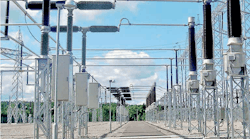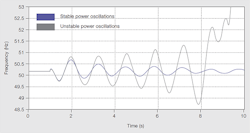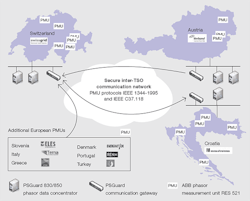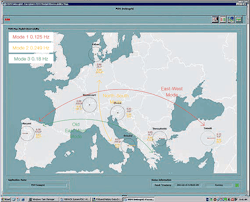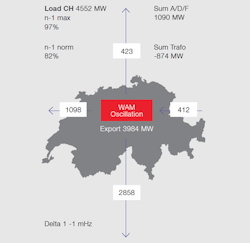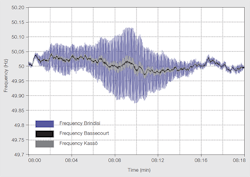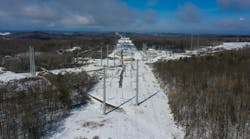The phenomenon of inter-area oscillation can arise when grids are interconnected. In a large grid like the European one, thousands of power stations work together to supply the total load on the grid. The electrical machines in these power stations are kept rotating synchronously through their interconnection with power transmission lines. Should a machine rotate slower than the average machine speed in the system, it will automatically absorb energy from the grid to bring its speed up to the average value again. On the other hand, a machine rotating faster than the average will supply extra energy to the grid to reduce its speed.
The torque that is applied to the generator shaft due to this self-stabilizing effect is called synchronizing torque and is the most fundamental mechanism in making the interconnection of power grids possible. However, this mechanism also makes it possible for speed variations to propagate and spread across entire interconnected power grids.
Also, there are control systems connected to each generator that have the task of keeping the rotational speed, and consequently the frequency, at the generator site constant. A typical generator frequency variation occurring as a result of a local fault is shown in ➔ 1. Initially, the frequency increases since electrical energy cannot be supplied to the grid because of the fault, resulting in a higher speed. When the fault is cleared by disconnecting the faulty component, power transfer capability is restored and the machine – now operating above its rated speed – can again supply power to the grid, which decelerates the machine. When the generators’ control systems are well-tuned to the operating conditions the result is similar to the blue line in ➔ 1, where the oscillation is damped out in a matter of seconds. However, if the control systems are poorly tuned or malfunctioning, the result can be a growing oscillation – as illustrated by the grey line – that will eventually lead to a break-up of the interconnected system and possibly blackouts.
Detecting poorly damped oscillations
ABB has developed a real-time analysis tool called Power Damping Monitoring (PDM) that can detect poorly damped oscillations based on a system identification procedure using a phasor measurement unit (PMU). A PMU is a device that measures the grid voltage and frequency using a common synchronization time source.
Time synchronization allows synchronized real-time measurements of multiple remote measurement points. A PMU can be either a dedicated device or the PMU function can be integrated into a device such as a protective relay. ABB’s latest PMU – released at the start of 2015 – is called the RES670.
The PDM application provides information such as:
- The number of detected active oscillation modes.
- The frequency and damping of each mode.
- The amplitude of the oscillations in each mode and in each measurement signal.
- The modal observability, ie, a measure of how visible each oscillatory mode in each measurement signal is, as well as the relative phase in each measurement.
The mathematical background of the algorithm, results from simulation experiments and measurements in the Scandinavian power grid are described in [1]. It was benchmarked against other damping monitoring algorithms [2].
Wide-area monitoring system at Swissgrid
Since 2004, Swissgrid has been monitoring the Swiss transmission grid using a PSGuard wide-area monitoring system (WAMS) [3–6]. PSGuard enables integration of existing or newly installed PMUs into a WAMS, which allows phasor – ie, PMU – data to be collected at a central location. PSGuard is ABB’s platform for widearea solutions based on synchrophasors and it enables power utilities to introduce WAMS technology stepwise with minimal investment. PSGuard provides the operator with system supervision displays, trends, and event and alarm lists. The Swissgrid system was successively extended and is now interconnected with PSGuard systems in Austria and Croatia, enabling the real-time exchange of phasor data. Additionally, phasor measurements are exchanged with WAMS systems from other vendors in Denmark, Slovenia, Italy, Portugal, Greece and Turkey. Phasor data is transferred using the synchrophasor standard protocol (IEEE C.37-118) over a secure Inter-TSO (transmission system operator) communication network.
In total, the Swissgrid WAMS system collects data from 22 PMUs with a time resolution of 10 Hz. The setup now has excellent capabilities for monitoring inter-area oscillations in the ENTSO-E (European Network of Transmission System Operators for Electricity) Continental European Synchronous Area (CESA). The architecture of the hierarchical WAMS system at Swissgrid is illustrated in ➔ 2.
Inter-area oscillations in the ENTSO-E power system
n extensive interconnected power system such as the ENTSO-E CESA – which encompasses Portugal to the west, Denmark to the north, Italy to the south and Turkey to the east – harbors a large number of oscillatory modes. These modes range from local plant modes with a relatively high frequency of 0.9 to 2 Hz to the slow, dominant inter-area modes that relate to differences in the coherent speed of generators in one entire network and that of generators in other network areas. Although the damping monitoring application will also detect local modes, the investigation here focuses on the inter-area modes. In September 2010, the Turkish power grid was connected for a period in a trial mode to the ENTSO-E CESA system. The addition of Turkey resulted in a new dominant mode.
A damping monitoring application has been in operation at Swissgrid since December 2010 and it has continuously monitored the damping and frequency of inter-area modes in the CESA system. The application has been configured to use real-time frequency measurements with a time resolution of 10 Hz from the seven PMU locations shown with circles in ➔ 3. This figure also illustrates the interarea oscillation modes that have been detected by the damping monitoring application in the CESA system.
The east-west mode involves the coherent movement of generators in Portugal and Spain against those in Turkey. This mode typically displays a frequency of 0.13 to 0.15 Hz and appeared following the connection of Turkey. Under normal operating conditions, this is the dominant mode with the most oscillatory energy. Prior to the connection, detailed simulation studies and measures were taken to ensure damping of this anticipated mode. Those measures included, for example, retuning power system stabilizers and the addition of active shunt methods such as static compensation (STATCOM) and static var compensation (SVC) with damping modules. The field recordings using WAMS indicate that those measures have been effective. The estimated time-domain damping is, most of the time, in the interval of 45 to 70 percent, which ABB considers adequate [3].
Detection and mitigation of critical oscillations
The dominant modes depicted in ➔ 3 are continuously monitored by performing online modal analysis and related parameter identification. If the system damping for one of the significant modes becomes too low and there is a large oscillation amplitude for longer than a few oscillation cycles, specific alarms are transmitted from the WAMS to the SCADA (supervisory control and data acquisition) environment at Swissgrid. The operators are then notified through a red box that pops up on one of the main SCADA overview displays as illustrated in ➔ 4.
As an example, one critical inter-area oscillation occurred on February 19, 2011 – a Sunday morning – when the Italian power system oscillated against the rest of the continental European system [7]. The event occurred in the early morning after generation was redispatched to accommodate a large injection of solar power in southern Italy. In contrast to most conventional power plants, solar power plants typically lack the control systems needed to damp out oscillations. The solar power injection resulted in a growing oscillation ➔ 5. This large oscillation was successfully detected by the PDM analysis tool and the operators were notified promptly. The operators could then redispatch the generation to reduce power import to Italy after around 8 minutes. Had the oscillation gone unnoticed and been allowed to grow further, it is likely that a breakup of the European power network would have occurred. This proves the value of the synchrophasor technology and the new monitoring application in increasing the security of the power supply.
Mats Larsson
ABB Corporate Research
Baden-Dättwil, Switzerland
[email protected]
Luis-Fabiano Santos
ABB Power Systems, Substation Automation Systems
Baden, Switzerland
[email protected]
---------------------------------------
References
[1] M. Larsson, D.S. Laila, “Monitoring of inter-area oscillations under ambient conditions using subspace identification,” PES ‘09, Calgary, 2009, pp. 1–6.
[2] J. Turunen et al., “Comparison of Three Electromechanical Oscillation Damping Estimation Methods,” IEEE Transactions on Power Systems, vol. 26, no. 4, pp. 2398–2407, 2011.
[3] W. Sattinger et al., “Operational Experience with Wide-Area Monitoring Systems,” CIGRE 2006 Session, B5-216.
[4] W. Sattinger et al., “A new dimension in grid monitoring,” Transmission & Distribution World, 2 2007, pp. 54–60.
[5] A.G. Phadke, “The Wide World of Wide-area Measurement,” IEEE Power & Energy Magazine, 2008, pp.52–65.
[6] M. Zima et al., “Design Aspects for Wide-Area Monitoring and Control Systems,” Proceedings of the IEEE, vol. 93, no. 5, 2005, pp. 980–996.
[7] ENTSO-E, Analysis of CE Inter-Area Oscillation of 19th and 24th February 2011, September 2011.
